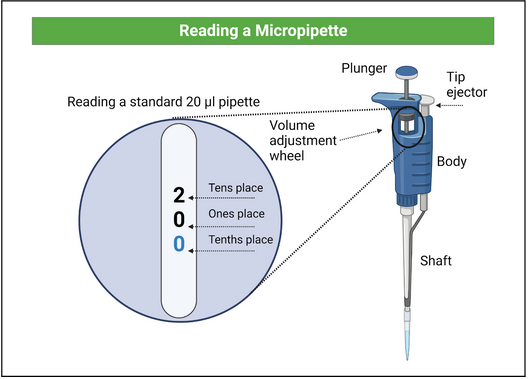2 Preparation
How to use a micropipette – We will practice pipetting small volumes of colorful liquids using micropipettes. We will work together to practice this new skill to improve our technique. Before coming to the lab, watch this 5-minute video, How to Micropipette, that demonstrates 3 key pipetting skills:
Learning Objectives
- How to hold a micropipette
- How to set a micropipette to a desired volume
- How to use the plunger and ejector of the micropipette to measure a desired volume of a reagent

To summarize proper micropipette use to measure a volume of liquid:
Key Takeaways
- To draw up liquid: 1. Set volume using the volume adjustment wheel 2. Press a new tip onto the shaft 3. Press plunger TO the FIRST STOP 4. Dip tip into liquid 5. Slowly release the plunger to collect liquid into the tip.
- To dispense sample: 1. Touch tip to dispensing container 2. Press plunger THROUGH to the SECOND STOP 3. Remove tip from liquid then release plunger 4. Dispose of tip using the tip ejector
- “Press the plunger TO the first stop to measure up liquid. Press the plunger THROUGH the second stop to dispense liquid out.”
Reducing waste – micropipette tips – Pipetting best practices dictate that a new micropipette tip should be used every time you pipette a new volume of liquid. This can be very important in avoiding contamination in molecular biology. Unfortunately, this also creates a considerable amount of plastic waste. For this activity, to reduce unnecessary waste, we will reuse tips when only pipetting water.

